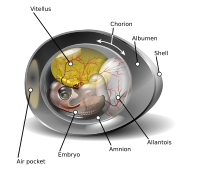
Photo from wikipedia
In thermal burn patients, epidermis and dermis are damaged and the barrier function of the skin is lost. This leads to fluid, nutrients and heat loss along with the increased… Click to show full abstract
In thermal burn patients, epidermis and dermis are damaged and the barrier function of the skin is lost. This leads to fluid, nutrients and heat loss along with the increased risk of microbial contamination. Both inadequate resuscitation and over resuscitation are deleterious to health. The increasing trend of overhydrating patients is well reported, and various guidelines to prevent this are in practice. Given its easy availability and cost-effectiveness, the human amniotic membrane can be used as a temporary barrier dressing. The aims of this study are (1) to evaluate the efficacy of amniotic membrane in decreasing the amount of replacement fluid in burn patients and (2) to measure the difference of fluid requirement by application of amniotic membrane compared with Parkland formula. Patients admitted to our institution between December 2016 and January 2018, who underwent early burn blister debridement with human amniotic membrane application, were included in this study. In this case-control study of thermal burn patients (including both adults and children), comparisons were made between historical patients from hospital record who also had equivalent burns and were managed by conventional prevailing dressing (cotton gauze dressings) against prospectively collected patients in whom entire burn surface was completely covered with human amniotic membrane dressing. The intravenous requirement in the historical group was generally based on Parkland formula calculation and strict urinary output maintenance. In the prospective group, the desired urinary output was maintained, and accordingly intravenous fluid was titrated to the necessary minimum. The fluids administered in the first 24 and 48 h were compared against the fluid requirement as per the Parkland formula. In our study, we found a mean reduction of 25.52% requirement of resuscitation fluid in the first 24 h after application of the human amniotic membrane. Our study provides evidence that the application of human amniotic membrane allows us to successfully resuscitate burn victims with lesser intravenous fluid than prescribed by Parkland formula. Human amniotic membrane dressing can be a good addition to colloid infusion in preventing fluid creep.
Journal Title: Indian Journal of Surgery
Year Published: 2020
Link to full text (if available)
Share on Social Media: Sign Up to like & get
recommendations!